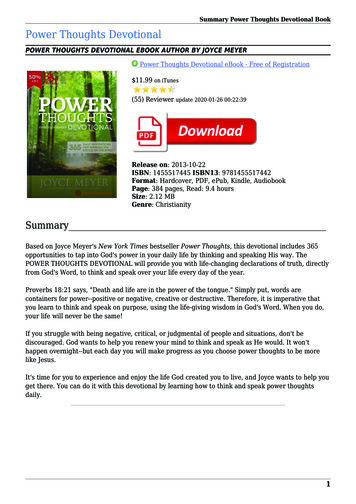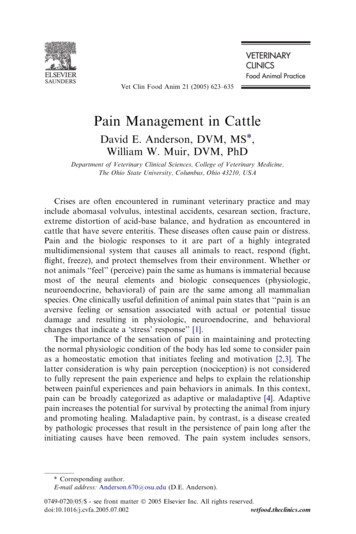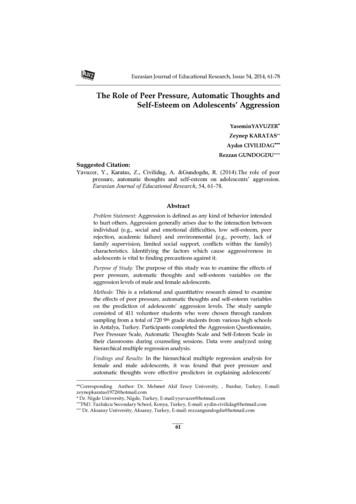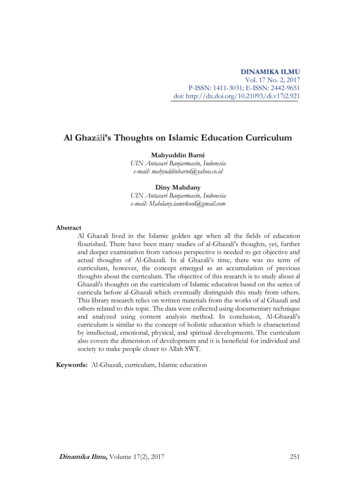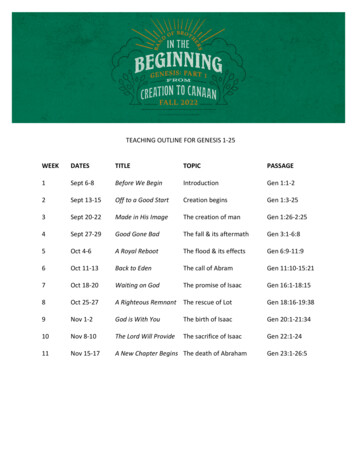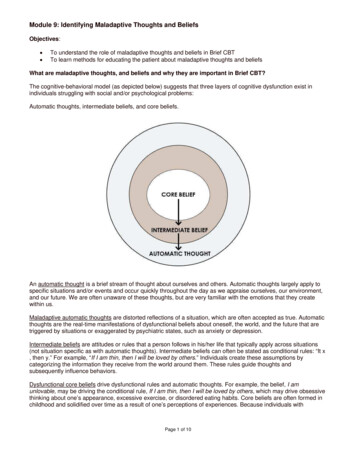
Transcription
Module 9: Identifying Maladaptive Thoughts and BeliefsObjectives: To understand the role of maladaptive thoughts and beliefs in Brief CBTTo learn methods for educating the patient about maladaptive thoughts and beliefsWhat are maladaptive thoughts, and beliefs and why they are important in Brief CBT?The cognitive-behavioral model (as depicted below) suggests that three layers of cognitive dysfunction exist inindividuals struggling with social and/or psychological problems:Automatic thoughts, intermediate beliefs, and core beliefs.An automatic thought is a brief stream of thought about ourselves and others. Automatic thoughts largely apply tospecific situations and/or events and occur quickly throughout the day as we appraise ourselves, our environment,and our future. We are often unaware of these thoughts, but are very familiar with the emotions that they createwithin us.Maladaptive automatic thoughts are distorted reflections of a situation, which are often accepted as true. Automaticthoughts are the real-time manifestations of dysfunctional beliefs about oneself, the world, and the future that aretriggered by situations or exaggerated by psychiatric states, such as anxiety or depression.Intermediate beliefs are attitudes or rules that a person follows in his/her life that typically apply across situations(not situation specific as with automatic thoughts). Intermediate beliefs can often be stated as conditional rules: “It x, then y.” For example, “If I am thin, then I will be loved by others.” Individuals create these assumptions bycategorizing the information they receive from the world around them. These rules guide thoughts andsubsequently influence behaviors.Dysfunctional core beliefs drive dysfunctional rules and automatic thoughts. For example, the belief, I amunlovable, may be driving the conditional rule, If I am thin, then I will be loved by others, which may drive obsessivethinking about one’s appearance, excessive exercise, or disordered eating habits. Core beliefs are often formed inchildhood and solidified over time as a result of one’s perceptions of experiences. Because individuals withPage 1 of 10
psychological disorders tend to store information consistent with negative beliefs but ignore evidence thatcontradicts them, core beliefs tend to be rigid and pervasive. Although automatic thoughts are often tied to aspecific situational trigger, intermediate and core beliefs are more global and cut across domains. Beck suggeststhat individuals tend to have core beliefs that involve either interpersonal (“I’m unlovable”) or achievement issues(“I’m incompetent”).When? (Indications/Contraindications)Identifying maladaptive automatic thoughts is the first step in the cognitive component of therapy. The focus ofintervention in Brief CBT is the dysfunctional automatic thought. Patients must master identifying and challengingthoughts to be able to grasp the concept and techniques of challenging beliefs. Because of the interrelated natureof thoughts and beliefs, an intervention targeting automatic thoughts may also change underlying beliefs (depictedbelow). Therefore, Brief CBT can result in belief modification, even if the target of treatment was automaticthoughts.Because patients progress through treatment at different rates, you may be able to identify and challenge somebeliefs late in brief therapy (sessions 5-8) for some patients. For other patients, work will be limited to automaticthoughts.Because skill building to alleviate symptoms and prevent relapse is a central focus of CBT, mastery ofskills is paramount. Focus on building a skill set with the patient that he or she can generalize to differentsituations, thoughts, or beliefs. It is less important to identify and modify deep-seated childhood beliefs.For most patients in Brief CBT, this will not be necessary for symptom reduction. However, some patientsmay benefit from this work.Although you may not discuss beliefs directly with the patient, as part of the case conceptualization, he/she shouldconstantly be forming hypotheses about what beliefs may be driving the thoughts (see Module 4: CaseConceptualization and Treatment Planning).Page 2 of 10
In identifying thoughts and beliefs, ask yourself several questions. Is the thought/belief secondary to another thought/belief?How much does the patient believe it?Does it affect the patient’s life negatively?Is the patient prepared to work on it now, or should he/she tackle the belief at a later date?After an automatic thought or belief is identified, it is challenged using the skills in Module 9.How? (Instructions/Handouts)Explaining Automatic Thoughts to Your PatientIt is important for the patient to understand the rationale for identifying automatic thoughts before acquiring the skillof addressing his/her own thoughts. Using the situation thought feeling triangle introduced in Module 5(Orienting the Patient to Brief CBT) can be helpful in explaining automatic thoughts. Completing the triangle withthe patient’s recent or current automatic thoughts can facilitate his/her understanding.Therapist: “So, Pamela, how have you been feeling this week?”Pamela: “Just really sad as usual. It seems like I’m always feeling that way.”Therapist: “Did anything in particular trigger this sad feeling this weekend?”Pamela: “Yes, I had to go to my cousin’s wedding, and it was really difficult because I started thinkingabout how I will never get married.”Therapist: “Pamela, that’s what we call an automatic thought. It’s something that just pops intoour heads over and over again without our really thinking about it or examining the truth of thethought. It affects the way we feel and act in a negative way. Maybe we should look at some ofyour automatic thoughts a little closer.”Using the patient's example, describe the association between thoughts and feelings to build awareness of theconnection. This is a good time for the patient to write down the thought and begin using the cognitive-behavioralmodel.Therapist: “So, let’s write down this automatic thought that you are having. I will never getmarried. Your going to your cousin’s wedding was the situation that triggered the thought, ‘I willnever get married’.Pamela: “Yes, that’s true.”Therapist: “When you were at the wedding and that thought came to you, how did you feel?”Pamela: “I felt really sad and hopeless.”Therapist: So, can you see how our thoughts can affect our mood and change the way we arefeeling?”Pamela: “Yeah, I guess if I hadn’t had that thought, I wouldn’t have felt so bad.”Page 3 of 10
Eliciting Automatic ThoughtsIt is important for therapists to teach patients how to identify automatic thoughts during and outside of session.Automatic Thoughts in SessionBe aware of patient’s hot thoughts during sessions. Hot thoughts are automatic thoughts that occur in combinationwith a change in emotion or mood. Hot thoughts are particularly poignant or strong thoughts that are oftenassociated with dysfunctional core beliefs, and should be targeted in therapy. Hot thoughts and the accompanyingsituation and emotion are tracked on the first three columns of the thought record (see p. 47).To identify which automatic thoughts are “hot”, the therapist listens for verbal cues, such as the language used inthe thought (see Cognitive Distortion worksheet, p. 49), and watches nonverbal cues, such as increased volume ofspeech or fidgeting. Changes in facial expression, shifts in position, or hand movements can be helpful indetermining whether a patient is experiencing an automatic hot thought. Listening to tone, pitch, volume, and thepace of a patient’s speech is also beneficial. When you notice these actions, this is an opportune time to bring it tothe patient’s attention and assist him/her in identifying an automatic thought associated with the shift in emotions. Inthese instances, you are simply an observer of the behavior and make a note of your observation to the patient(“You are speaking more loudly; what is going through your mind right now?”). The patient then provides anexplanation of the behavior.Page 4 of 10
Patient: “My boss reprimanded me again yesterday” (sighs heavily.)Therapist: “Tell me more.”Patient: “Well, we were at a meeting; and I had just made my presentation, and he said he had expecteda better product for the client. (voice gets softer, begins wringing hands).Therapist: “Your voice changed a little when you said that; tell me what is going through yourmind right now?”Patient: “I just feel like a failure at everything. My work has always been the one thing I was good at, andnow I am failing at that, too.”Therapist: “Let’s take a look at that line of thinking and the feelings it creates. It seems that whenthat thought entered your mind, your mood changed very quickly. Did you notice that?”Patient: “Yeah, I guess it did upset me pretty fast.”You usually will also need to use specific questions to elicit an automatic hot thought. These questions are found inModule 10.Automatic Thoughts Between SessionsIn Brief CBT, a principal characteristic is the work the patient does outside of session. Because identifyingautomatic thoughts is a novel concept to many, practicing outside of session will facilitate movement and change intherapy. In fact, Burns and Nolen-Hoeksema (1992) found that patients who completed homework had significantlybetter treatment outcomes than those who did not. Practicing key skills between sessions allows session time to beused for new skill acquisition and troubleshooting. Initially, when a specific situation is brought up in session,always ask, “What was going through your mind at that moment?”This helps the patient build awareness of his/her automatic thought, both within and outside of session.Because automatic thoughts may occur outside awareness, asking for a more detailed description of the situation isalso helpful in pinpointing maladaptive thoughts. For example, you could "take the patient back" to when ithappened, using imagery (e.g., Where were you when this happened? What time of day was it?). If the patientreverts to past tense, remind him/her to tell the story in present tense to help bring back the thoughts and feelingsthat occurred in this situation.With continued questioning, it is possible that there may be more than one automatic thought associated with aproblematic situation. Elicit and record all automatic thoughts given for a particular situation.Page 5 of 10
Therapist: “Craig, what else were you thinking during this phone call with your wife?”Craig: “I was thinking that she knows how bad I feel for not coming to the party and she wants me tofeel even worse.”Therapist: “So you weren’t thinking only that they were using you. You were also thinking thatthey knew you felt bad, and they wanted you to feel worse?”Craig: “Yes.”Therapist: “So, that is really three different thoughts that you were having that were creatingfeelings of anger?”Craig: “I guess so.”Remember that a patient’s automatic thoughts should be the actual words or images that go through his or hermind. Patients (or therapists) may often interpret or rephrase thoughts; however, the goal is to get unprocessedthoughts verbatim.Deciding Which Automatic Thoughts to Focus OnOnce a patient becomes aware of how many automatic thoughts he/she has, he/she may feel overwhelmed by theirsheer number. Uncovering one thought may lead to another and so on. Therefore, it is important to focus on themost important automatic thoughts and the hot thoughts that are likely to bring about the greatest change. Thereare several things a patient can do once he or she has identified an automatic thought. The patient can decide tofocus on that thought, choose another thought associated with the situation, or move on to another topic if he/shefeels that there is a more powerful thought that he/she would like to tackle.You can help the patient choose automatic thoughts to focus on by frequently checking: Goals for this sessionPatient’s agenda items and addressing those problemsThe importance of the thought chosen in reaching therapeutic goalsAnother technique is to identify a few automatic thoughts and then rate them on a scale of 0-100, based on howintense the associated feeling is (rate the feeling from 0-100), and how much he/she believes the thought (ratebelievability from 0-100). This helps to quantify which automatic thoughts are most important. The thoughts with thestrongest ratings should be considered first.Dysfunctional automatic thoughts often fall into certain categories. These are common "cognitive distortions" orthinking errors. Identifying patterns of cognitive distortions in the patient's thought records or speech is instrumentalfor choosing a hot thought, case conceptualization, and treatment planning. A patient often has one or two commonpatterns of maladaptive thinking. Identifying these patterns helps him/her identify them when they come up andprovides you an opportunity to intervene on a thought triggered in multiple situations. Therefore, changing aparticular thought that is part of a dysfunctional thinking pattern (e.g., tendency to ignore the positive) may havemultiple benefits for the patient. For list of common thinking errors, see the Cognitive Distortion worksheet (page49).Intermediate BeliefsTo identify an intermediate belief, you must first know how to recognize a patient’s automatic thoughts. You can dothis by identifying an automatic thought and then attempting to identify an attitude or assumption the patient feelsabout him-/herself, the future, others, or the world. These assumptions can be identified by listening for themes inthe patient’s thoughts and behavior. You can use several techniques to identify an intermediate belief:Page 6 of 10
Look for an intermediate belief that comes in the form of a patient’s automatic thought.Provide the first part of an assumption (“If x ”), and enlist the help of the patient to complete it.Elicit a rule or an attitude from the patient, and change it into an assumption.Look for themes in the patient’s automatic thoughts. Either come up with a hypothesis, or ask the patient toidentify a theme.Ask the patient directly about his or her beliefs.Have the patient complete a questionnaire or inventory that will help identify his/her beliefs (e.g.,Dysfunctional Attitudes Scale). Core BeliefsThroughout therapy, hypothesize core beliefs that may be underlying dysfunctional behaviors and thoughts. Thesehypotheses aid development of the case conceptualization and treatment plan (see Module 5). A belief that is likelyto be core will appear in several different areas of the patient’s life (i.e., relationships, work, parenting).If time permits in Brief CBT, after you have collected enough evidence to support the alleged core belief, presentand discuss it with the patient.“I’ve heard you say several times that you either didn’t do a good job, or that someone else put in moretime and energy. It seems to me that you feel inadequate a lot of the time. Is that right?”At this point, you can also elicit childhood experiences consistent with the belief. This helps identify the possibleorigin of the belief and helps you explain it to the patient. In educating the patient about core beliefs, make several things clear:Core beliefs are only ideas. Feeling them strongly does not make them true.These beliefs started developing during childhood. The patient believes them today because he/she hasstored evidence to support them and rejected evidence to contradict them.These beliefs can be tested and changed through use of the techniques that will be taught in therapy.Example Homework Assignments1.2.3.4.Keep a notepad with you and attempt to list automatic thoughts you have during the day.Use the triangle diagram to dissect three to five situations when you experienced a strong emotion.Create a list of assumptions and evidence for and against those assumptions.Complete the first three sections of the Thought Record for one to two situations.Supplemental ReadingsBeck, J.S. (1995). Cognitive therapy: Basics and beyond. New York: Guilford Press; Chapters 6, 7, 8, 10,and 11.Safran, J.D. & Greenberg, L.S. (1982). Elicitiing “hot cognitions” in cognitive behavioral therapy: Rationaleand procedural guidelines. Canadian Psychology, 23, 83-86.Greenberg, D. & Padesky, C. A. (1995). Mind over mood: Changing the way you feelby changing the way you think. New York: Guilford Press; Chapters 5, 6, 7, and 9.Page 7 of 10
THOUGHT RECORD(1) SituationOut of breathwhen I played inthe park with mygranddaughterWhat actuallyhappened?Where? What?How? When?(2) AutomaticThought(s)(3) Emotion(s) &MoodI’m too old to playwith her.DefeatedI can’t do what Iused to do.SadI can’t be hercaregiver.SadI have nothing tooffer my familyany more.DisappointedHopelessI am a burden tomy family.HopelessWorthlessI am no good tomy family.Hopeless (80)Worthless (90)What thought(s)went throughyour mind?How much didyou believe it?(1-100)What emotion(s)did you feel atthe time? Ratehow intense theywere (1-100).(4) Evidence toSupport Thought(5) Evidence ThatDoesn't SupportThoughtWhat hashappenedto make youbelieve thethought is true?What hashappened toprove thethought is nottrue?Page 8 of 10(6) AlternativeThoughtWhat is anotherway to think ofthis situation?(7) RateMood Now0-100
Helpful QuestionsSituational Questions What happened? What were you doing? Who was there? Who were you speaking to? When did this happen? What time of day was it?Feeling QuestionsThought Questions How were you feeling before thishappened? What was going through your mindbefore you started to feel that way? How did you feel while it was happening? What made you feel that way? What mood were you in after thishappened? Do you have any other thoughts? Can you rate your mood on a scale of 1100? Which thought bothered you the most? What images did you have with thesethoughts? Where did this incident occur? What are you afraid might happen? What if this is true? What does this sayabout you? What could happen if this were true? What other ways could we think of this?Page 9 of 10
Cognitive Distortions1. All-or-nothing thinking: Viewing situations on one extreme or another instead of on a continuum.Ex. “If my child does bad things, it’s because I am a bad parent.”2. Catastrophizing: Predicting only negative outcomes for the future.Ex. “If I fail my final, my life will be over.”3. Disqualifying or discounting the positive: Telling yourself that the good things that happen to you don’tcount.Ex. “My daughter told her friend that I was the best Dad in the world, but I’m sure she was just beingnice.”4. Emotional reasoning: Letting one’s feeling about something overrule facts to the contrary.Ex. “Even though Steve is here at work late every day, I know I work harder than anyone else at myjob.”5. Labeling: Giving someone or something a label without finding out more about it/them.Ex. “My daughter would never do anything I disapproved of.”6. Magnification/minimization: Emphasizing the negative or playing down the positive of a situation.Ex. “My professor said he made some corrections on my paper, so I know I’ll probably fail the class.”7. Mental filter/tunnel vision: Placing all one’s attention o, or seeing only, the negatives of a situation.Ex. “My husband says he wishes I was better at housekeeping, so I must be a lousy wife.”8. Mind reading: Believing you know what others are thinking.Ex. “My house was dirty when my friends came over, so I know they think I’m a slob.”Ex. “My daughter’s boyfriend got suspended from school. He’s a loser and won’t ever amount toanything.”9. Overgeneralization: Making an overall negative conclusion beyond the current situation.Ex. “My husband didn’t kiss me when he came home this evening. Maybe he doesn’t love me anymore.”10. Personalization: Thinking the negative behavior of others has something to do with you.Ex. “My daughter has been pretty quiet today. I wonder what I did to upset her.”11. “Should” and “must” statements: Having a concrete idea of how people should behave.Ex “I should get all A’s to be a good student.”Page 10 of 10
thought. It affects the way we feel and act in a negative way. Maybe we should look at some of your automatic thoughts a little closer." Therapist: "So, let's write down this automatic thought that you are having. I will never get married. Your going to your cousin's wedding was the situation that triggered the thought, 'I will


